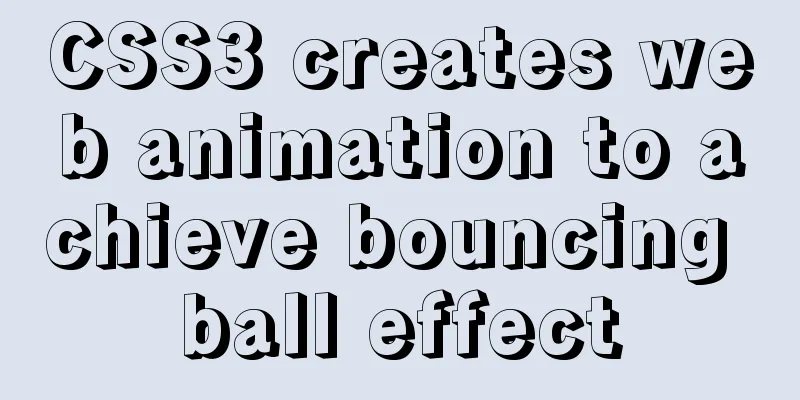CSS3 creates web animation to achieve bouncing ball effect

|
Basic preparation For this implementation, we need a simple div with the class name ball: HTML code: <div class="ball"></div> We will use Flexbox layout to put the ball in the middle of the page, with a size of 100px * 100px and an orange background color. CSS code:
body {
display: flex; /* Use Flex layout */
justify-content: center; /* Horizontally center */
}
.ball {
width: 100px;
height: 100px;
border-radius: 50%; /* Turn the square into a circle */
background-color: #FF5722; /* Set the color to orange */
}Creating Keyframes Keyframes are used in CSS animations so that we have full control over the animation. Creating a Keyframe style is very simple. We use the keyword @keyframes followed by the name of the animation: CSS code:
@keyframes nameOfAnimation {
/* code */
}In this example, we name the keyframe bounce. In Keyframe, use the from and to keywords to specify the CSS styles for the start and end points of the animation. CSS code:
@keyframes bounce {
from { /* start */ }
to { /* end */ }
}Simple, isn’t it? As a final step, we can add CSS styles for our start and end points. To create the bounce effect we will simply change the position of the ball. transform allows us to modify the coordinates of a given element. Here is the final keyframe: CSS code:
@keyframes bounce {
from { transform: translate3d(0, 0, 0); }
to { transform: translate3d(0, 200px, 0); }
}We use transform to translate the ball along the three-dimensional axis. The translate3D function requires three input parameters, namely (x, y, z). Since we want the ball to bounce up and down, we only need to translate along the y-axis. Therefore, the y value of the animation end point (that is, the style in to) becomes 200px. Run Keyframe Now that the @keyframe is created, it's time to put it to work! Go back to .ball{} css and add the following line of code: CSS code:
.ball {
/* ... */
animation: bounce 0.5s;
animation-direction: alternate;
animation-iteration-count: infinite;
}Explain these three lines of code: Tell the ball element to bounce using our keyframe rules. Set the duration of the animation to complete to .5 seconds. After completion, the animation is executed in the opposite direction (reversed). Run the animation an unlimited number of times. Awesome, so far. This is close to what we want, but not perfect yet: It doesn't look like a bouncing ball. That's because we didn't set a speed curve for the animation, so it will be set to ease by default. This means that the animation starts slow, speeds up in the middle, and slows down again near the end. Unfortunately, this isn't ideal for a bouncing ball. Luckily, we can use Math to customize this speed curve! Without going into too much detail, you can use bezier curves to specify custom animation timings. Here is the attached code: CSS code:
.ball {
/* ... */
animation: bounce 0.5s cubic-bezier(.5,0.05,1,.5);
}Of course this is the simplest animation effect created with CSS Animations and Keyframes. Summarize The above is what I introduced to you about how to use CSS3 to create web animations to achieve bouncing ball effects. I hope it will be helpful to you. If you have any questions, please leave me a message and I will reply to you in time. I would also like to thank everyone for their support of the 123WORDPRESS.COM website! |
<<: How to start multiple MySQL databases on a Linux host
Recommend
Example of using supervisor to manage nginx+tomcat containers
need: Use docker to start nginx + tomcat dual pro...
JavaScript to achieve simple tab bar switching case
This article shares the specific code for JavaScr...
The implementation principle of Mysql master-slave synchronization
1. What is MySQL master-slave synchronization? Wh...
MySQL 8.0.20 installation and configuration tutorial under Docker
Docker installs MySQL version 8.0.20 for your ref...
Vue realizes screen adaptation of large screen pages
This article shares the specific code of Vue to a...
The perfect solution to the Chinese garbled characters in mysql6.x under win7
1. Stop the MySQL service in the command line: ne...
MySQL database query performance optimization strategy
Optimize queries Use the Explain statement to ana...
Detailed explanation of redundant and duplicate indexes in MySQL
MySQL allows you to create multiple indexes on th...
Install tomcat and deploy the website under Linux (recommended)
Install jdk: Oracle official download https://www...
Analysis of the Linux input subsystem framework principle
Input subsystem framework The linux input subsyst...
File backup solution between servers, how to automatically back up server files to another server?
Many organizations have the need to back up file ...
Open the Windows server port (take port 8080 as an example)
What is a Port? The ports we usually refer to are...
Mysql optimization techniques for querying dates based on time
For example, to query yesterday's newly regis...
Docker+K8S cluster environment construction and distributed application deployment
1. Install Docker yum install docker #Start the s...
MYSQL unlock and lock table introduction
MySQL Lock Overview Compared with other databases...










